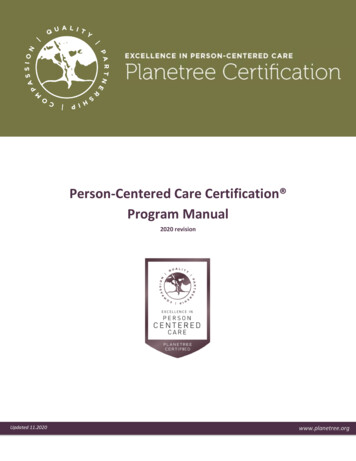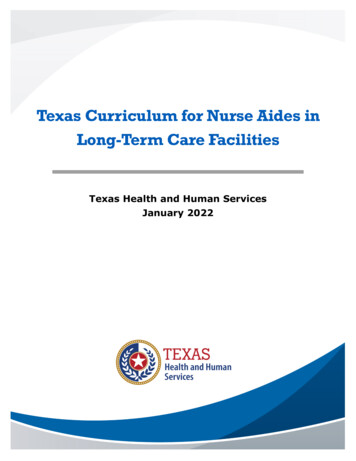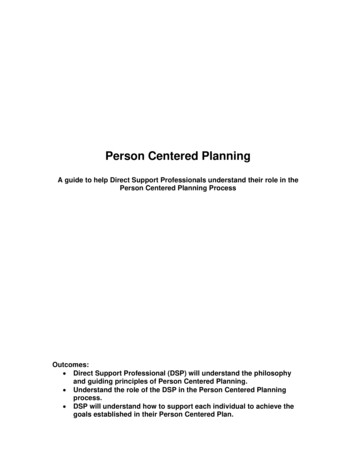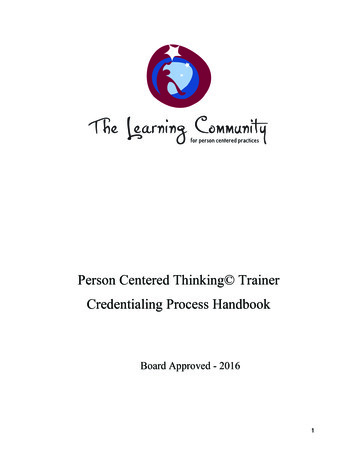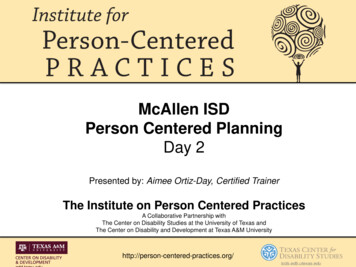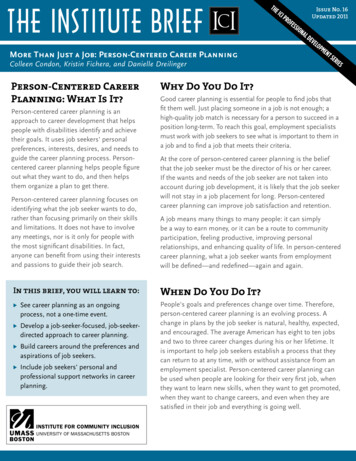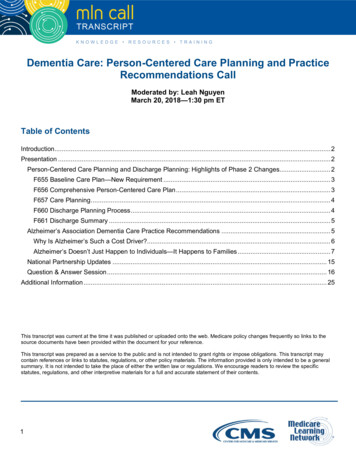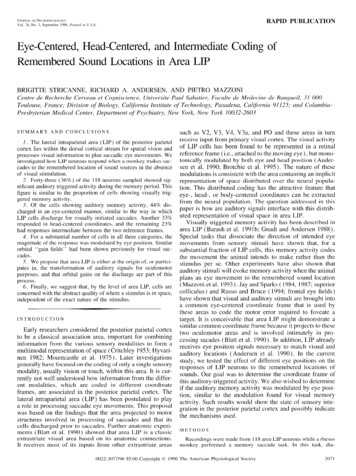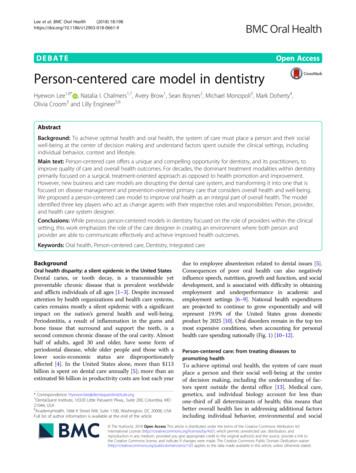
Transcription
Lee et al. BMC Oral Health(2018) ATEOpen AccessPerson-centered care model in dentistryHyewon Lee1,8* , Natalia I. Chalmers1,7, Avery Brow1, Sean Boynes2, Michael Monopoli3, Mark Doherty4,Olivia Croom3 and Lilly Engineer5,6AbstractBackground: To achieve optimal health and oral health, the system of care must place a person and their socialwell-being at the center of decision making and understand factors spent outside the clinical settings, includingindividual behavior, context and lifestyle.Main text: Person-centered care offers a unique and compelling opportunity for dentistry, and its practitioners, toimprove quality of care and overall health outcomes. For decades, the dominant treatment modalities within dentistryprimarily focused on a surgical, treatment-oriented approach as opposed to health promotion and improvement.However, new business and care models are disrupting the dental care system, and transforming it into one that isfocused on disease management and prevention-oriented primary care that considers overall health and well-being.We proposed a person-centered care model to improve oral health as an integral part of overall health. The modelidentified three key players who act as change agents with their respective roles and responsibilities: Person, provider,and health care system designer.Conclusions: While previous person-centered models in dentistry focused on the role of providers within the clinicalsetting, this work emphasizes the role of the care designer in creating an environment where both person andprovider are able to communicate effectively and achieve improved health outcomes.Keywords: Oral health, Person-centered care, Dentistry, Integrated careBackgroundOral health disparity: a silent epidemic in the United StatesDental caries, or tooth decay, is a transmissible yetpreventable chronic disease that is prevalent worldwideand afflicts individuals of all ages [1–3]. Despite increasedattention by health organizations and health care systems,caries remains mostly a silent epidemic with a significantimpact on the nation’s general health and well-being.Periodontitis, a result of inflammation in the gums andbone tissue that surround and support the teeth, is asecond common chronic disease of the oral cavity. Almosthalf of adults, aged 30 and older, have some form ofperiodontal disease, while older people and those with alower socio-economic status are disproportionatelyaffected [4]. In the United States alone, more than 113billion is spent on dental care annually [5]; more than anestimated 6 billion in productivity costs are lost each year* Correspondence: Hyewon.lee@dentaquestinstitute.org1DentaQuest Institute, 10320 Little Patuxent Pkwy., Suite 200, Columbia, MD21044, USA8AcademyHealth, 1666 K Street NW, Suite 1100, Washington, DC 20006, USAFull list of author information is available at the end of the articledue to employee absenteeism related to dental issues [5].Consequences of poor oral health can also negativelyinfluence speech, nutrition, growth and function, and socialdevelopment, and is associated with difficulty in obtainingemployment and underperformance in academic andemployment settings [6–9]. National health expendituresare projected to continue to grow exponentially and willrepresent 19.9% of the United States gross domesticproduct by 2025 [10]. Oral disorders remain in the top tenmost expensive conditions, when accounting for personalhealth care spending nationally (Fig. 1) [10–12].Person-centered care: from treating diseases topromoting healthTo achieve optimal oral health, the system of care mustplace a person and their social well-being at the centerof decision making, including the understanding of factors spent outside the dental office [13]. Medical care,genetics, and individual biology account for less thanone-third of all determinants of health; this means thatbetter overall health lies in addressing additional factorsincluding individual behavior, environmental and social The Author(s). 2018 Open Access This article is distributed under the terms of the Creative Commons Attribution 4.0International License (http://creativecommons.org/licenses/by/4.0/), which permits unrestricted use, distribution, andreproduction in any medium, provided you give appropriate credit to the original author(s) and the source, provide a link tothe Creative Commons license, and indicate if changes were made. The Creative Commons Public Domain Dedication o/1.0/) applies to the data made available in this article, unless otherwise stated.
Lee et al. BMC Oral Health(2018) 18:198Page 2 of 7Fig. 1 US Spending on Personal Health Care and Public Health, 1996–2013 [11]circumstances of patients [14, 15]. Therefore, contextand lifestyle have significant roles in improving andmaintaining optimal oral health.To improve health outcomes for patients, the NationalAcademy of Medicine (NAM; formerly the Institutes ofMedicine) recognized the need for a patient-centeredmodel of health care. The NAM thus defined the concept of patient-centered care as the provision of care“that is respectful of and responsive to individual patientpreferences, needs, and values, and ensuring that patientvalues guide all clinical decisions” [16]. More recently,NAM focused on the integration of oral health and primary care as well as particularly challenging aspects ofbridging oral health and primary care for populationswith low health literacy [17]. The implementation ofpatient-centered care has subsequently demonstrated reductions in annual overall medical care charges [18], thepromotion of effective change for patients and healthcare professionals, and improvements in patient satisfaction [19, 20]. This model of care has also shown improvements in overall patient health when theytransition from pediatric to adult primary care [21].A related but distinct approach, person-centered carehas since developed, marking a transition from the medical patient, to the whole person. This shift in focusingon the person rather than the patient is based on the“accumulated knowledge of people, which provides thebasis for better recognition of health problems andneeds over time,” and helps to “facilitate appropriatecare for these needs in the context of other needs” [22].Person-centered care developed out of the nursing,gerontology and long-term care fields [23] as eachrecognized the growing importance of a person’s livingenvironment, resources and self-management capacity inpredicting disease outcomes. This approach has resultedin improvements in addressing chronic conditions andincreased patient satisfaction with care providers, as wellas concurrent reductions in the likelihood of treatmentfailures [13].Main textOral health as an integral part of overall healthPerson-centered care offers a unique and compelling opportunity for dentistry and its practitioners to improvethe quality of care and overall health outcomes. For decades, the dominant treatment modalities in dentistryprimarily focused on a surgical, treatment-oriented approach as opposed to health promotion and improvement. However, new business and care models aredisrupting the dental care system, and transforming intoone that is focused on disease management andprevention-oriented primary care that considers overallhealth and well-being.Mounting evidence shows the bi-directional relationshipbetween oral health and other systemic diseases like diabetes [24–29]. Studies have shown that patients with diabetes have increased prevalence, severity and acceleratedprogression of periodontitis compared to those withoutdiabetes [25, 27, 28]. Also, uncontrolled periodontitisnegatively affects glycemic control in patients with diabetes [26, 29], and periodontal intervention may reducemedical costs and improve health outcomes among individuals diagnosed with type 2 diabetes [30, 31]. Designingand implementing a person-centered care model in
Lee et al. BMC Oral Health(2018) 18:198Page 3 of 7dentistry, dental professionals are supported by a system ofcare that reinforces collaboration with other health careprofessionals in improving the overall health and well-beingof person with diabetes. Oral diseases also share commoncauses with other non-communicable and chronic diseasesand risk factors, like high sugar intake and smoking.Despite the importance of oral health as an integral partof overall health, oral health is frequently omitted fromdisease management plans and health education due tothe historic separation between medicine and dentistry.Multiple person-centered care models are used globallybut they lack consensus concerning a basic definition ofperson-centered care within dentistry due to varied interpretations and applications of the concept [32, 33]. Somesuggest a conceptual-based approach while others proposea clinically-based model for person-centered care.Person-centered care and patient-centered care, thoughseparate concepts, are used interchangeably without aclear distinction between the two [32–34]. Moreover,there is limited evidence demonstrating improved oralhealth outcomes with a person-centered approach in dentistry, compared to medicine [33, 34].To prevent any health risks originating from poor oralhealth and to improve overall health and well-being, aperson-centered care approach that integrates oralhealth into overall health must be a critical element inboth care design and delivery.Proposed person-centered care model in dentistry:Person, provider, care designerPerson-centered care starts with learning the contextualelements surrounding and shaping a person’s behavior, decisions, and barriers to health. Then, the person-providerteam applies that contextual knowledge to develop opportunities that will help attain the best health outcomes possible. Health care system designers should empower theperson-provider team through the development and function of health care systems where this team can achieveimproved health outcomes. Care designers are entities andsystems rather than personnel who create infrastructurefor the person-provider team. Examples include hospitalsand clinics, community organizations, public or privatemedical and dental insurance entities, and the local, stateand federal government. Their primary role is to designand operate a system of care that contextually assures theperson-provider relationship forms in the most meaningful and efficient way. This model identifies three keyplayers as change agents and the respective roles and responsibilities (Table 1) [35].Within a person-centered care environment, a personis a recipient of care, and can act as a partner whoco-designs his/her care delivery. Additionally, familiesand caregivers are often involved in the course of treatment and present during interactions with providers,and they can actively engage in care policy and practiceTable 1 Person-Centered Care Model: Three Key Players and Their Roles and FunctionsACTIONPerson or Primary CaretakerProvider – CoachCare DesignerLean Examine Learn about his or her oral health Learn about the person’s oral healthstatus during the initial exam and and medical health as supported byperiodic follow-up, which couldexamination and medical recordstake place outside a dental officeor by a non-dentist member of thetreatment teamLearn and examine current person-centered caremodels in both dental and non-dental healthcare fieldsRelate ShareRelate their oral health andgeneral healthRelate oral health with other medicalconditionsShare findings and interconnections betweenoral health and overall health with the personand other healthcare providers as necessaryRelate those successful approaches to revise andexpand its operations and services to achieve itsmissionShare opportunities and new findings internallyPlan DesignPlan for preventive intervention,definitive treatment, behaviormodification and lifestyle changeswith providersPlan for preventive interventions, definitivetreatments, and behavior modifications thatthe person agrees uponDesign or redesign a system of care to improvehealth outcomes, reduce cost of care, andincrease satisfaction of the care experience forboth patient and providers [35]Design financial incentives and alternativepayment designs that reflect evidence-baseddental practice and knowledge.Act ProvideAct upon the agreed planTrack EvaluateProvide preventive interventions, definitivetreatments, and behavior modifications thatthe person agrees upon, using available tools,techniques and clinical support;Track and Evaluate the progress of theperson’s adherence to the agreed planImplement a designed system of care.Track the progress of implemented systemdesignsEvaluate progress and outcomesReviseRevise the plan together with the personto achieve the set goals.Revise the design of the care system byincorporating the voices of persons andproviders, as well as analyzes, shares and appliesany emerging knowledge gleaned.Revise the plan and adjust asnecessary to achieve meaningfulyet practical goals in consultationwith his/her provider.
Lee et al. BMC Oral Health(2018) 18:198improvement through patient and family advisory councils. Providers include health care professionals, community outreach personnel, clinical and administrative staff,who interact directly or indirectly with the person toachieve a common goal: improving oral health and theoverall health of the person. Depending on the nature ofdisease and health concerns, a multidisciplinary team ofhealth professionals can interact with the person in bothclinical and non-clinical settings. To empower thisperson-provider team, care designers must developvalue-supported systems, encourage personal health ownership, and create financial structures and payment environments that incentivize health. Sophisticated paymentdesign may include co-incentives for medical and dentalteams when a person’s health outcomes improve throughapplication of person-centered medical and dental care.The evaluation of a person-centered care system’s success can be aligned with major health quality measuresalready in use. These include measures endorsed by theNational Quality Forum (NQF) outlined in HealthyPeople 2020, as well as other measures based on patientsatisfaction surveys and quality of life assessments andevaluations. Additionally, care designers must also demonstrate that their person-centered care models directlyimprove population health and develop specific goals forimprovement, especially for persons with chronic conditions. This framework is applied in Table 2 showing theutilization of this approach for a person with diabetes.Other chronic conditions may also benefit from the application of this approach. Dental caries is an infectiousdisease and cariogenic bacteria can be transmitted fromcaregivers to young children; this early transmission increases children’s risk for the disease [36]. Translating thisscientific knowledge to practice, care designers are able tocreate systems of care that provide oral health educationand treatment to pregnant women so they can modifytheir lifestyle and receive dental services prior to givingbirth. Providers can address specific concerns related topregnant women through this person-centered care approach, such as the infectious nature of oral disease,morning sickness, prevention of erosion and others. Providers can also consider treatment plan modifications andpossible use of alternative medicines that are based on theunique physiology of pregnant women.Person-centered care is not limited to the structuralboundaries of the clinics. For children who reside in communities and with difficulty accessing oral health care,care designers can collaborate to offer alternative treatment modalities in non-traditional clinic settings, likeschool-based clinics or mobile dental services. These canbe feasible options for individuals with a lack of structuraland geographical access to dental services. With all threeparticipants in this person-centered approach, patienthealth and safety are optimized and risks are minimized.Page 4 of 7Optimization of a person’s health: an integrated systemsapproachTreatment and management of oral disease often requires coordination of care beyond the delivery of preventive and restorative treatments at the dental facility.Transportation, navigating care, and collaboration withother multidisciplinary team members to address bothoral and overall health are also necessary [37]. Vital tosuccess is ensuring a system design that respects the dignity of the person and allowing for structured access todesired and required health care.Previous person-centered care models within dentistryowed lack of success in part to only a defined role of providers in clinical settings. Our model highlights the essential role of the care designer within the broader system tocreate environments and vehicles for providers to practicea person-centered approach in the most meaningful andeffective ways. The person-centered approach in dentistrymust include the care designer as an active and competentplayer for a sustained system benefit. Without supportsystems, coverage, or incentives, neither the person norprovider can pursue a person-centered care approach.Future challengesExisting challenges to person-centered care within dentistry are substantial and include limitations in health information technology, particularly a lack of medical-dentalelectronic record interoperability, and a lack of effectivemodels for care coordination. There are insufficient sociodemographic information collection mechanisms in dentistry from either individuals or provider. By investing in,and strengthening existing health information technologyplatforms, and beginning the integration of predictive dataanalysis using consumer-based, sociodemographic data,care designers and providers can begin to overcome someof these inherent challenges that currently hinder widespread adoption of person-centered care models.Designers should identify key stakeholders and partners who understand the person-centered care, the existing challenges encountered by patients, and who share acommon vision to demonstrate the value found in utilizing this approach. Focused person-centered care demonstration projects can show improvement in healthoutcomes and care experiences in specific contexts.Thus, care designer’s person-centered care models aimfor adaptability, which means that inputs from theperson-provider team can, and should, modify the modelperiodically and when needed.Position oral health as primary careThe crucial final strategy for this person-centered approach in dentistry is to position oral health as an integral and necessary part of primary health care servicesand attainment. In recent years, multiple health care
Lee et al. BMC Oral Health(2018) 18:198Page 5 of 7Table 2 Person-Centered Care in Dentistry: Person-Centered Care for Person with DiabetesPersonProvidersLearn Learn current oral health status andproblems Learn optimal oral health hygienehabits, and diet patternLearn/ExamineLearn/Examine Learn about the person’s oral health and diabetes Learn and examine existing oral health carestatus supported by medical records and a clinicalmodels and person-centered care models forexaminationpeople with diabetes Learn personal barriers making it difficult to achieve Learn the geographical context (state law,optimal oral health and diabetes controlcoverage, oral health and health needs) to design Perform diabetes screening and check blooda care model that is the best fit for the contextglucose level or HA1cCare designerRelate Understand how oral health isrelated to diabetes Relate daily oral hygiene habits, anddiet pattern to oral healthRelate Relate oral health conditions to current diabetesstatus and other medical conditions Relate a person’s barriers to ideal care to a futureplanShare Communicate with the person about the oralsystemic link in context of diabetes Share both oral and medical findings with aperson’s primary care provider team as necessaryand inform them about the oral-systemic link indiabetes context. Share how the person can improve oral health anddiabetes status both in and out of clinical settings.Relate Relate those successful person- centered caremodels in designing operative system Relate current models to the target communityand state demographic and characteristicsShare Share opportunities to implement person-centeredcare in people with diabetes with internalstakeholders Develop an oral-systemic link message forproviders to share with persons with diabetes Share person-centered care model outcomes withboth internal and external partnersPlan Set personal oral health goals andplan out actionable items Decide on treatment plan withproviderPlan Present treatment and behavior modification planto the person for an informed decisionDesign Design a system that incentivizes person-providerteams who meet key person-centered caremeasures Design a coordinated care system that existsbetween medical and dental providersAct Actively participate in the agreedplan in both prevention andtreatment procedures Modify oral hygiene habits and dietpattern as planned outside of theclinical settingProvide Provide preventive and or definitive care asplannedTrack Track the person’s adherence to the agreed plan,progress on oral health improvement and diabetescontrolEvaluate Evaluate the progress on pre-determinedevaluation measuresImplement Implement demonstration projects to improvehealth of the diabetic population, a reduction inboth medical and dental costs, and an increase insatisfaction of the care experience of both personand providersTrack Track the progress of the implemented personcentered care model Support person-provider team to track theprogress using health information technology andpersonalized health platformEvaluate Develop a set of evaluation tools that are alignedwith major oral health and diabetes measuresRevise Revise plans based on personalexperience, diabetes status, and oralhealth outcomes from the currentplanRevise Revise the plan with the person to achieve the setgoals or to modify the goalRevise Revise the person-centered care modelincorporating reflections from people with diabetesand providers Modify person-centered care models for diabetesto improve care outcomes, costs, and careexperienceSource: The person-centered care approach to improving the oral health of all: A Framework for DentaQuestorganizations and clinical leaders have recognized the important role oral health has in primary health care andhighlight the integral part it plays in overall health [38–41].In addition, recommendations have been established bythe Health Resources and Services Administration (HRSA)that set forth competencies for inter-professional oralhealth practices [42]. Primary care teams have the experience, skills and close relationships with communitymembers that allow them to accomplish effective prevention and disease management. A paradigm shift in thecommon perception of oral health care from a surgicaltreatment-oriented approach to one that is focused on disease management and prevention-oriented primary care isproposed, and this shift is reflected in both treatment andthe existing financial models.ConclusionsThe impact of disparities in oral health and the historicalchasm between medicine and dentistry are importantconsiderations in realizing the person-centered care
Lee et al. BMC Oral Health(2018) 18:198approach in dentistry. While previous person-centeredmodels in dentistry focused on the role of providerswithin the clinical setting [32–34], this work identifiesthree key players: person, provider and the care designer.To understand the contextual circumstances of individuals as well as that of practice management, the role ofthe care designer as a system enabler is essential, especially in creating an environment where both person andprovider are able to communicate effectively. Aligningevaluation of person-centered care within other majornational health measures improvements in health outcomes and cost-effectiveness to promote overall healthand well-being of “a person” as well as a “population”can be realized.AbbreviationsHRSA: Health Resources and Services Administration; NAM: NationalAcademy of Medicine (formerly the Institutes of Medicine); NQF: NationalQuality ForumAcknowledgmentsWe would like to thank Brian Novy, Biyi Ogunjimi, Linda Vidone, Tequila Terryand the DentaQuest Clinical Leadership Committee for providing meaningfulinsight and expertise that greatly assisted the development of this paper.FundingThere was no funding association with this work.Availability of data and materialsNot applicable.Authors’ contributionsEach author took part in the design of the concept, contributed to theframework development, participated in writing the manuscript. All authorsread and approved the final manuscript.Authors’ informationAt the time of submission, Dr. Chalmers’ affiliation was with DentaQuestInstitute, and her current position is with the U.S. Food and DrugAdministration.Ethics approval and consent to participateNot applicable.Consent for publicationNot applicable.Competing interestsHL, AB, SB, OC, MD, MM are members of DentaQuest Clinical LeadershipCommittee. The authors declare that they have no competing interests.Publisher’s NoteSpringer Nature remains neutral with regard to jurisdictional claims inpublished maps and institutional affiliations.Author details1DentaQuest Institute, 10320 Little Patuxent Pkwy., Suite 200, Columbia, MD21044, USA. 2DentaQuest Institute, 2400 Computer Dr, Westborough, MA01581, USA. 3DentaQuest Foundation, 465 Medford St, Boston, MA 02129,USA. 4Safety Net Solutions, DentaQuest Institute, 2400 Computer Dr,Westborough, MA 01581, USA. 5Department of Anesthesia and Critical CareMedicine, Johns Hopkins School of Medicine, Baltimore, MD 21205, USA.6Department of Health Policy and Management, Johns Hopkins BloombergSchool of Public Health, 600 N. Wolfe St, Baltimore, MD 21205, USA. 7Presentaddress: U.S. Food and Drug Administration, Silver Spring, USA.8AcademyHealth, 1666 K Street NW, Suite 1100, Washington, DC 20006, USA.Page 6 of 7Received: 25 July 2018 Accepted: 12 November 2018References1. Berkowitz RJ. Mutans streptococci: acquisition and transmission. PediatrDent. 2006;28(2):106–9 discussion 92-8.2. Caufield P, Griffen A. Dental caries: an infectious and transmissabledisease. Pediatr Clin N Am. 2000;47(5):1001–19. https://doi.org/10.1016/S0031-3655(05)70555-8.3. Selwitz RH, Ismail AI, Pitts NB. Dental caries. Lancet (London, England).2007;369(9555):51–9. https://doi.org/10.1016/s0140-6736(07)60031-2.4. Eke PI, Dye BA, Wei L, Thornton-Evans GO, Genco RJ. Prevalence ofperiodontitis in adults in the United States: 2009 and 2010. J Dent Res.2012;91(10):914–20. https://doi.org/10.1177/0022034512457373.5. Oral Health Basics [database on the Internet]. U.S. Department of Healthand Human Services. 2017. Available from: https://www.cdc.gov/oralhealth/basics/index.html. Accessed 1 July 2018.6. Oral Health in America. A Report of the Surgeon General. Rockville: U.S.Department Health and Human Services; 2000.7. Jackson SL, Vann WF Jr, Kotch JB, Pahel BT, Lee JY. Impact of poor oralhealth on children’s school attendance and performance. Am J PublicHealth. 2011;101(10):1900–6. https://doi.org/10.2105/ajph.2010.200915.8. Seirawan H, Faust S, Mulligan R. The impact of oral health on the academicperformance of disadvantaged children. Am J Public Health. 2012;102(9):1729–34. https://doi.org/10.2105/ajph.2011.300478.9. Hyde S, Satariano WA, Weintraub JA. Welfare dental intervention improvesemployment and quality of life. J Dent Res. 2006;85(1):79–84. https://doi.org/10.1177/154405910608500114.10. Keehan SP, Stone DA, Poisal JA, Cuckler GA, Sisko AM, Smith SD, et al.National Health Expenditure Projections, 2016-25: price increases, agingpush sector to 20 percent of economy. Health affairs (Project Hope). 2017;36(3):553–63. https://doi.org/10.1377/hlthaff.2016.1627.11. Dieleman JL, Baral R, Birger M, Bui AL, Bulchis A, Chapin A, et al. USspending on personal health care and public health, 1996-2013. JAMA.2016;316(24):2627–46. https://doi.org/10.1001/jama.2016.16885.12. Institute for Health Metrics and Evaluation (IHME). Health Care Spending inthe United States Infographic. Seattle: IHME, University of Washington, 2016.Available from pendingunited-states. Accessed 29 May 2018.13. Ekman I, Swedberg K, Taft C, Lindseth A, Norberg A, Brink E, et al. Personcentered care - ready for prime time. Eur J Cardiovasc Nurs. urse.2011.06.008.14. Edwin Choi H, Sonin J. Determinants of Health. Goinvo; 2016. lth/. Accessed 29 May 2018.15. Schroeder SA. We can do better — improving the health of the Americanpeople. N Engl J Med. 2007;357(12):1221–8. https://doi.org/10.1056/NEJMsa073350.16. Institute of Medicine Committee on Quality of Health Care. Crossing thequality chasm: a new health system for the 21st century. Washington (DC):National Academies Press (US) copyright 2001 by the National Academy ofSciences. All rights reserved; 2001.17. Atchison KA, Rozier RG, Weintraub JA. NAM Perspectives. Discussion Paper.Integration of oral health and primary care: Communication, coordination,and referral. Washington (DC): National Academy of Medicine; 2018. https://doi.org/10.31478/201810e.18. Bertakis K, Azari R. Determinants and outcomes of patient-centered care.Patient Educ Couns. 2011;85(1):46–52. https://doi.org/10.1016/j.pec.2010.08.001.19. Lusk JM, Fater K. A concept analysis of patient-centered care. Nurs Forum.2013;48(2):89–98. https://doi.org/10.1111/nuf.12019.20. Lauver DR, Ward SE, Heidrich SM, Keller ML, Bowers BJ, Brennan PF, et a
DEBATE Open Access Person-centered care model in dentistry Hyewon Lee1,8*, Natalia I. Chalmers1,7, Avery Brow1, Sean Boynes2, Michael Monopoli3, Mark Doherty4, Olivia Croom3 and Lilly Engineer5,6 Abstract Background: To achieve optimal health and oral health, the system of care must place a person and their social
